belt Acura Integra 2000 Hatchback Owner's Guide
[x] Cancel search | Manufacturer: ACURA, Model Year: 2000, Model line: Integra, Model: Acura Integra 2000Pages: 279, PDF Size: 3.57 MB
Page 30 of 279
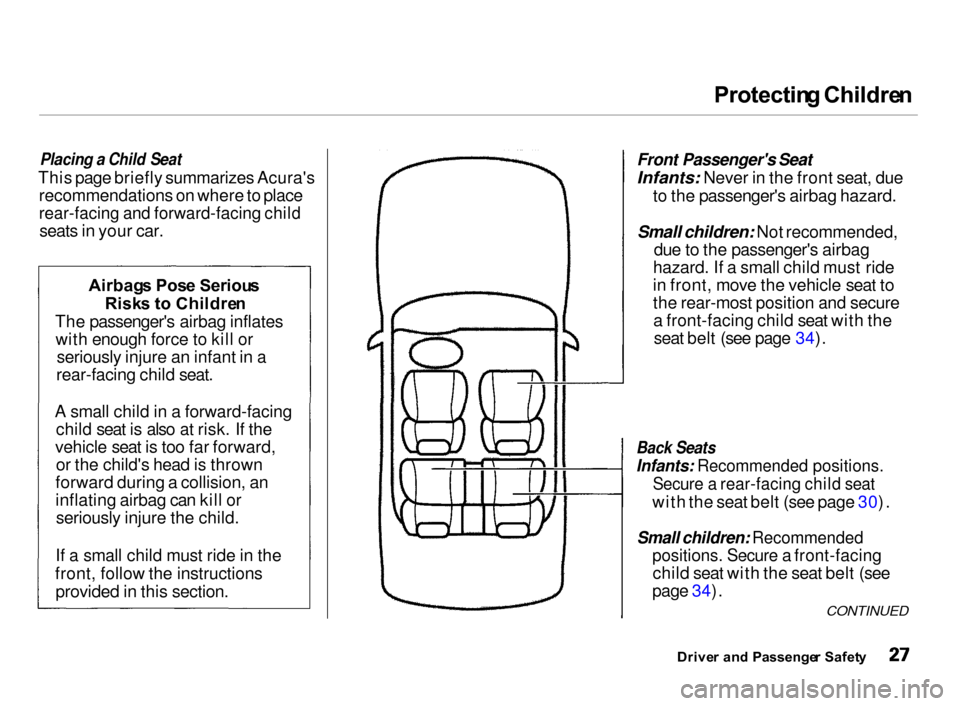
Protectin
g Childre n
Placing a Child Seat
This page briefly summarizes Acura's recommendations on where to place
rear-facing and forward-facing child
seats in your car.
Front Passenger's Seat
Infants: Never in the front seat, due
to the passenger's airbag hazard.
Small children: Not recommended,
due to the passenger's airbag
hazard. If a small child must ride
in front, move the vehicle seat to
the rear-most position and secure a front-facing child seat with theseat belt (see page 34).
Back Seats
Infants: Recommended positions.
Secure a rear-facing child seat
with the seat belt (see page 30).
Small children: Recommended
positions. Secure a front-facing
child seat with the seat belt (see
page 34).
Drive r an d Passenge r Safet y
Airbag
s Pos e Seriou s
Risk s t o Childre n
The passenger's airbag inflates with enough force to kill or seriously injure an infant in a
rear-facing child seat.
A small child in a forward-facing child seat is also at risk. If the
vehicle seat is too far forward, or the child's head is thrown
forward during a collision, an
inflating airbag can kill or seriously injure the child.
If a small child must ride in the
front, follow the instructions provided in this section.
CONTINUED
Page 31 of 279
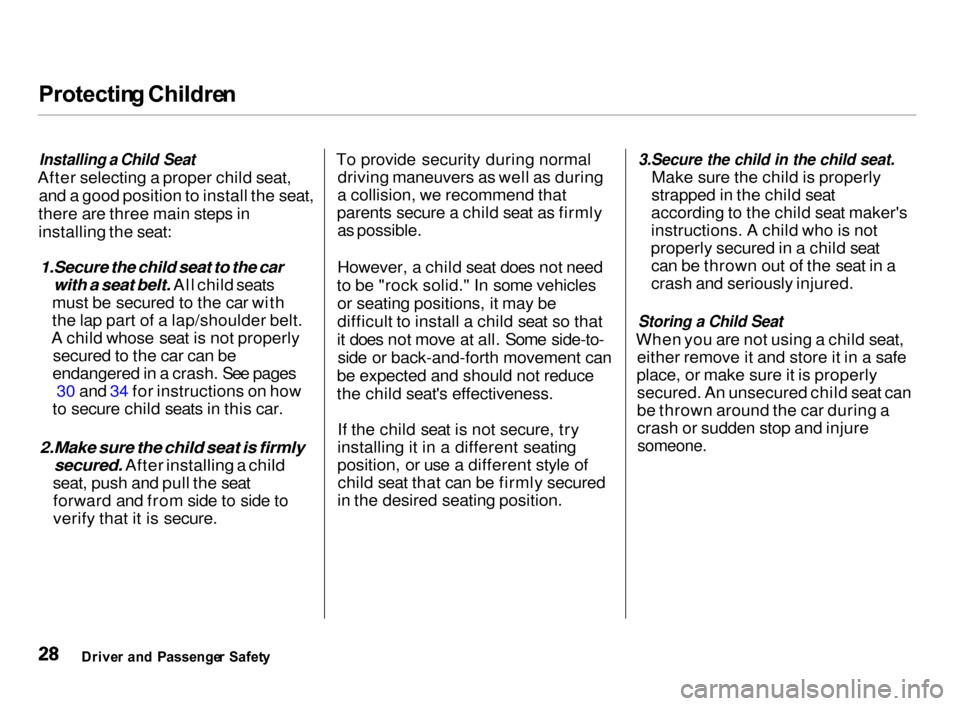
Protectin
g Childre n
Installing a Child Seat
After selecting a proper child seat, and a good position to install the seat,
there are three main steps in
installing the seat:
1.Secure the child seat to the car
with a seat belt. All child seats
must be secured to the car with
the lap part of a lap/shoulder belt.
A child whose seat is not properly secured to the car can be
endangered in a crash. See pages 30 and 34 for instructions on how
to secure child seats in this car.
2.Make sure the child seat is firmly
secured. After installing a child
seat, push and pull the seat forward and from side to side to
verify that it is secure.
To provide security during normal
driving maneuvers as well as during
a collision, we recommend that
parents secure a child seat as firmly as possible.
However, a child seat does not need
to be "rock solid." In some vehicles or seating positions, it may be
difficult to install a child seat so that
it does not move at all. Some side-to- side or back-and-forth movement can
be expected and should not reduce
the child seat's effectiveness.
If the child seat is not secure, try
installing it in a different seating
position, or use a different style of child seat that can be firmly secured
in the desired seating position.
3.Secure the child in the child seat.
Make sure the child is properly
strapped in the child seat
according to the child seat maker's
instructions. A child who is not
properly secured in a child seat can be thrown out of the seat in a
crash and seriously injured.
Storing a Child Seat
When you are not using a child seat, either remove it and store it in a safe
place, or make sure it is properly secured. An unsecured child seat can
be thrown around the car during a
crash or sudden stop and injure
someone.
Drive r an d Passenge r Safet y
Page 33 of 279
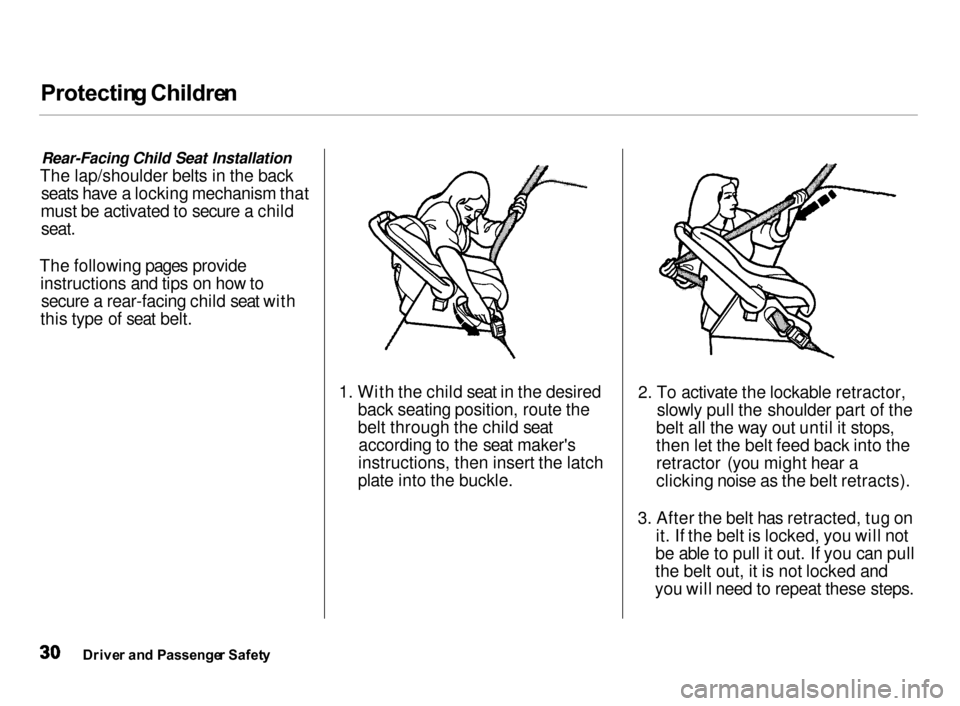
Protectin
g Childre n
Rear-Facing Child Seat Installation
The lap/shoulder belts in the back seats have a locking mechanism that
must be activated to secure a child
seat.
The following pages provide instructions and tips on how tosecure a rear-facing child seat with
this type of seat belt.
1. With the child seat in the desired
back seating position, route the
belt through the child seataccording to the seat maker's
instructions, then insert the latch
plate into the buckle.
2. To activate the lockable retractor,
slowly pull the shoulder part of the
belt all the way out until it stops,
then let the belt feed back into the
retractor (you might hear a
clicking noise as the belt retracts).
3. After the belt has retracted, tug on
it. If the belt is locked, you will not
be able to pull it out. If you can pull
the belt out, it is not locked and
you will need to repeat these steps.
Drive r an d Passenge r Safet y
Page 34 of 279
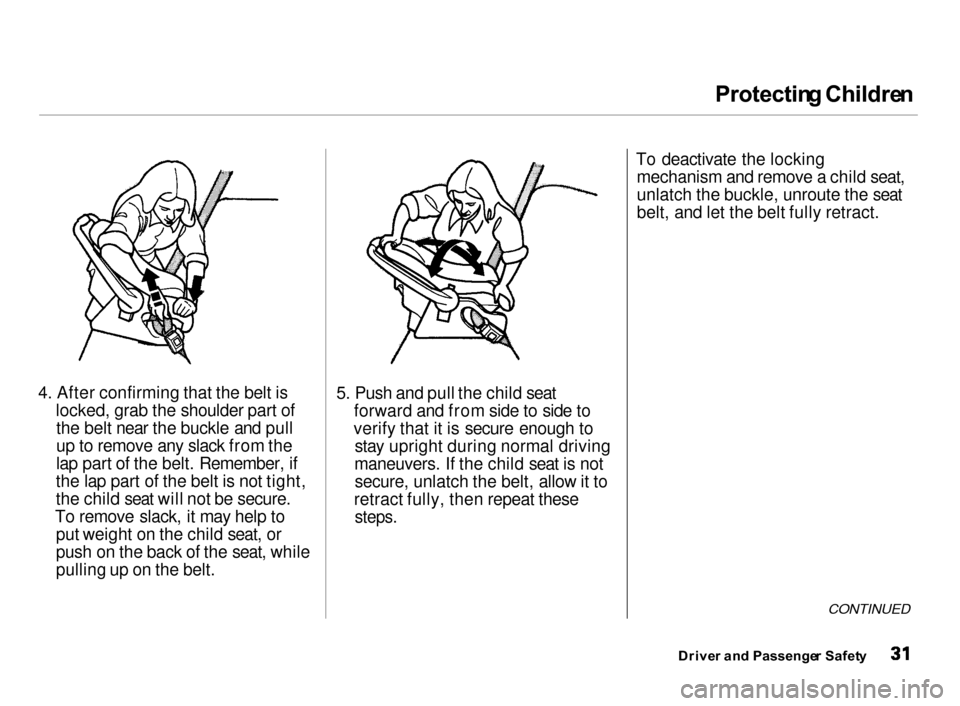
Protectin
g Childre n
4. After confirming that the belt is
locked, grab the shoulder part of the belt near the buckle and pull
up to remove any slack from the
lap part of the belt. Remember, if
the lap part of the belt is not tight,
the child seat will not be secure.
To remove slack, it may help to put weight on the child seat, or
push on the back of the seat, while
pulling up on the belt.
5. Push and pull the child seat
forward and from side to side to
verify that it is secure enough to stay upright during normal driving
maneuvers. If the child seat is not secure, unlatch the belt, allow it to
retract fully, then repeat these
steps.
To deactivate the locking
mechanism and remove a child seat,
unlatch the buckle, unroute the seat
belt, and let the belt fully retract.
CONTINUED
Drive r an d Passenge r Safet y
Page 35 of 279
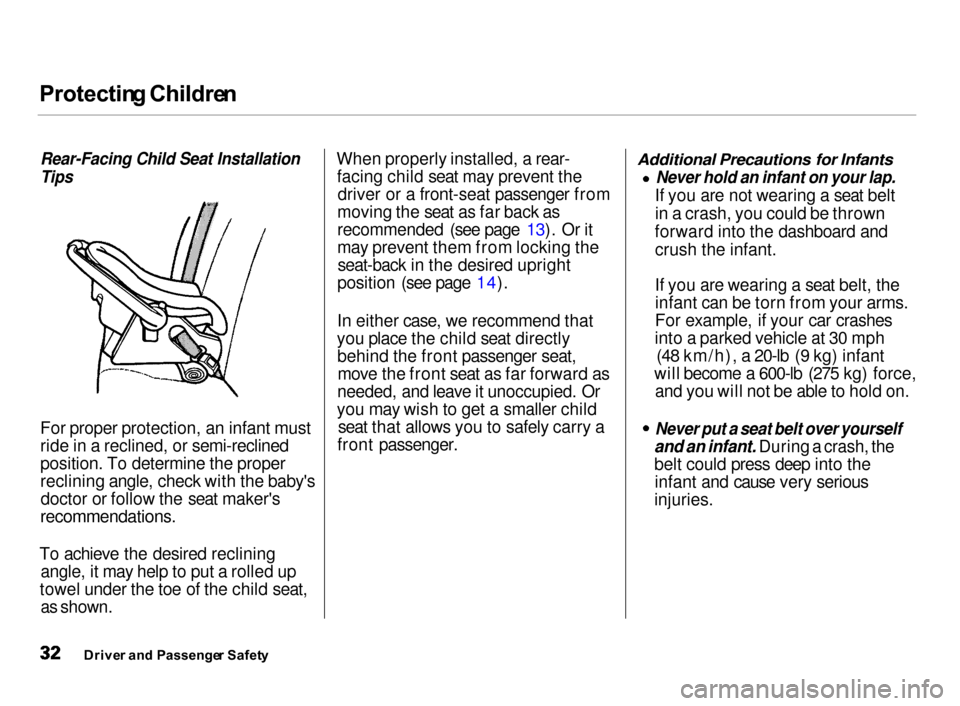
Protectin
g Childre n
Rear-Facing Child Seat Installation
Tips
For proper protection, an infant must
ride in a reclined, or semi-reclined
position. To determine the proper
reclining angle, check with the baby's doctor or follow the seat maker's
recommendations.
To achieve the desired reclining angle, it may help to put a rolled up
towel under the toe of the child seat,
as shown.
When properly installed, a rear-
facing child seat may prevent the driver or a front-seat passenger from
moving the seat as far back as
recommended (see page 13). Or it
may prevent them from locking the seat-back in the desired upright
position (see page 14).
In either case, we recommend that
you place the child seat directly behind the front passenger seat,move the front seat as far forward as
needed, and leave it unoccupied. Or
you may wish to get a smaller child seat that allows you to safely carry a
front passenger.
Additional Precautions for Infants
Never hold an infant on your lap.
If you are not wearing a seat belt
in a crash, you could be thrown
forward into the dashboard and crush the infant.
If you are wearing a seat belt, the
infant can be torn from your arms.
For example, if your car crashes
into a parked vehicle at 30 mph (48 km/h), a 20-lb (9 kg) infant
will become a 600-lb (275 kg) force, and you will not be able to hold on.
Never put a seat belt over yourself
and an infant. During a crash, the
belt could press deep into theinfant and cause very serious
injuries.
Drive r an d Passenge r Safet y
Page 37 of 279
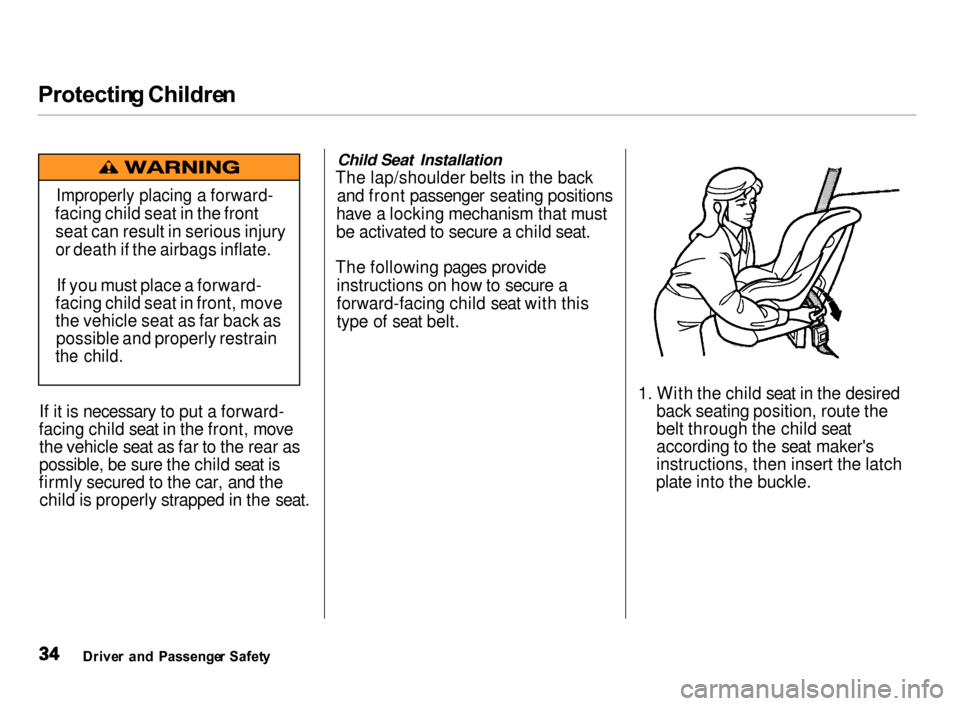
Protectin
g Childre n
If it is necessary to put a forward-
facing child seat in the front, move the vehicle seat as far to the rear as
possible, be sure the child seat is
firmly secured to the car, and the child is properly strapped in the seat.
Child Seat Installation
The lap/shoulder belts in the back and front passenger seating positions
have a locking mechanism that must
be activated to secure a child seat.
The following pages provide instructions on how to secure a
forward-facing child seat with this
type of seat belt.
1. With the child seat in the desired
back seating position, route the
belt through the child seat
according to the seat maker's
instructions, then insert the latch
plate into the buckle.
Drive r an d Passenge r Safet y
Improperly placing a forward-
facing child seat in the front seat can result in serious injury
or death if the airbags inflate.
If you must place a forward-
facing child seat in front, move
the vehicle seat as far back as possible and properly restrain
the child.
Page 38 of 279
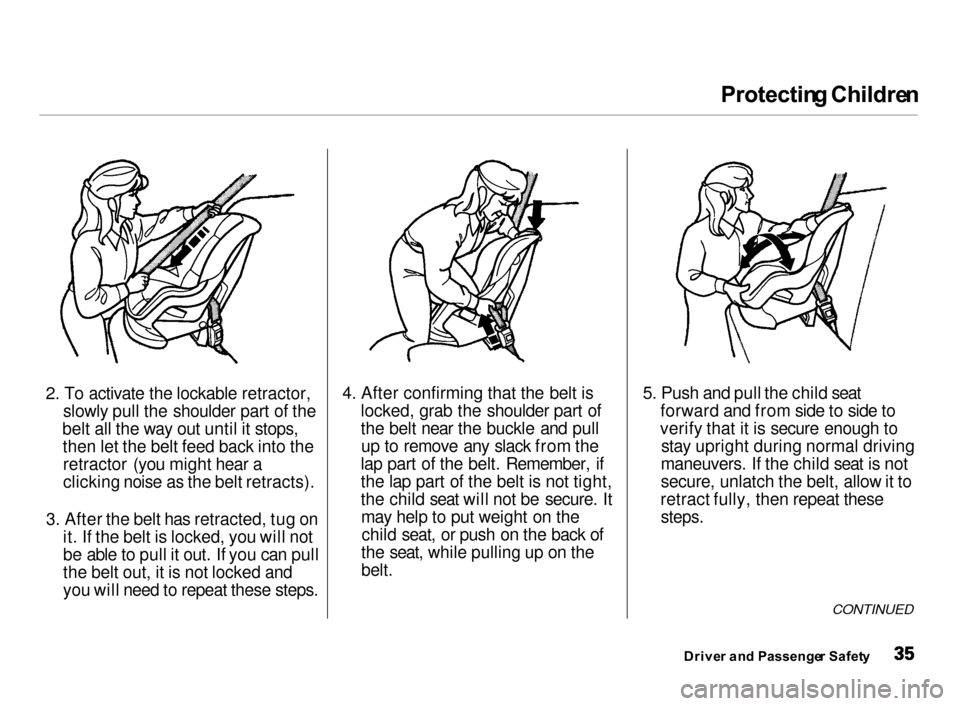
Protectin
g Childre n
2. To activate the lockable retractor, slowly pull the shoulder part of the
belt all the way out until it stops, then let the belt feed back into theretractor (you might hear a
clicking noise as the belt retracts).
3. After the belt has retracted, tug on it. If the belt is locked, you will not
be able to pull it out. If you can pull
the belt out, it is not locked and
you will need to repeat these steps. 4. After confirming that the belt is
locked, grab the shoulder part of
the belt near the buckle and pull
up to remove any slack from the
lap part of the belt. Remember, if
the lap part of the belt is not tight,
the child seat will not be secure. It may help to put weight on thechild seat, or push on the back of
the seat, while pulling up on the
belt.
5. Push and pull the child seat
forward and from side to side to
verify that it is secure enough to stay upright during normal driving
maneuvers. If the child seat is not
secure, unlatch the belt, allow it to
retract fully, then repeat these
steps.
CONTINUED
Drive r an d Passenge r Safet y
Page 39 of 279
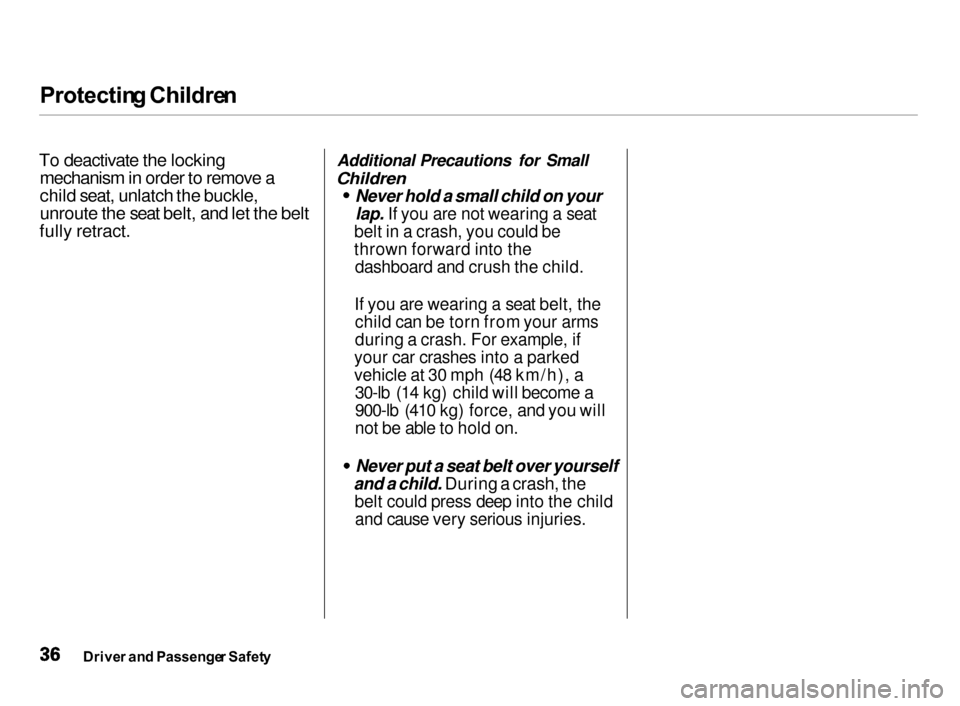
Protectin
g Childre n
To deactivate the locking
mechanism in order to remove a
child seat, unlatch the buckle,
unroute the seat belt, and let the belt
fully retract.
Additional Precautions for Small
Children Never hold a small child on your
lap. If you are not wearing a seat
belt in a crash, you could be
thrown forward into the dashboard and crush the child.
If you are wearing a seat belt, the child can be torn from your arms
during a crash. For example, if
your car crashes into a parked
vehicle at 30 mph (48 km/h), a 30-lb (14 kg) child will become a
900-lb (410 kg) force, and you will
not be able to hold on.
Never put a seat belt over yourself
and a child. During a crash, the
belt could press deep into the child
and cause very serious injuries.
Drive r an d Passenge r Safet y
Page 40 of 279
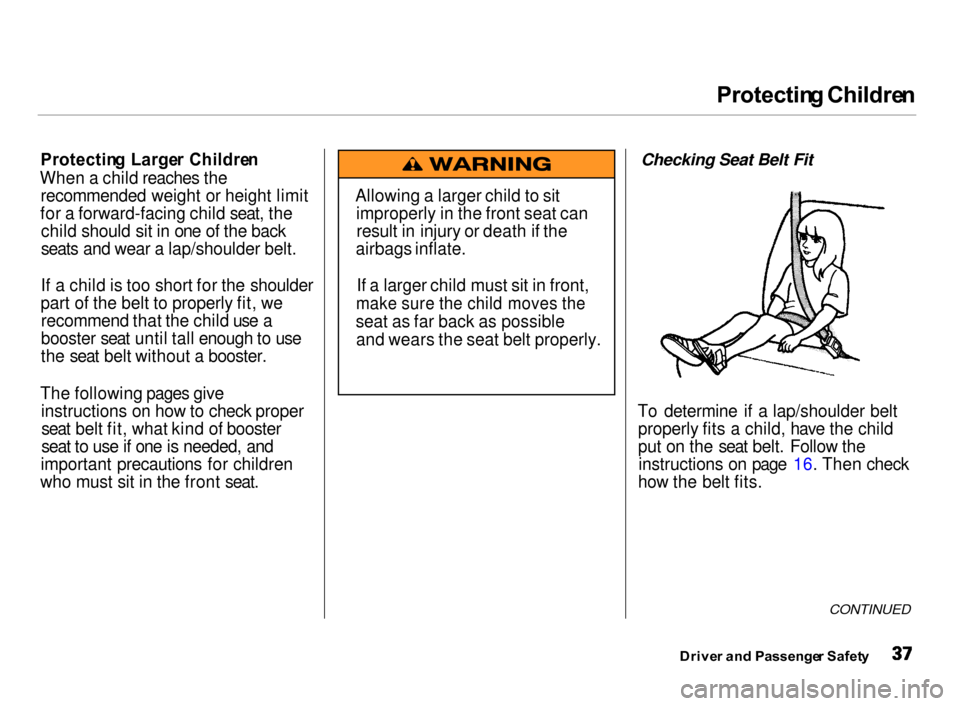
Protectin
g Childre n
Protectin g Large r Childre n
When a child reaches the recommended weight or height limit
for a forward-facing child seat, the child should sit in one of the back
seats and wear a lap/shoulder belt.
If a child is too short for the shoulder
part of the belt to properly fit, we recommend that the child use a
booster seat until tall enough to use
the seat belt without a booster.
The following pages give instructions on how to check properseat belt fit, what kind of booster
seat to use if one is needed, and
important precautions for children
who must sit in the front seat.
Checking Seat Belt Fit
To determine if a lap/shoulder belt properly fits a child, have the child
put on the seat belt. Follow theinstructions on page 16. Then check
how the belt fits.
CONTINUED
Drive r an d Passenge r Safet y
Allowing a larger child to sit
improperly in the front seat canresult in injury or death if the
airbags inflate.
If a larger child must sit in front,
make sure the child moves the
seat as far back as possible and wears the seat belt properly.
Page 41 of 279
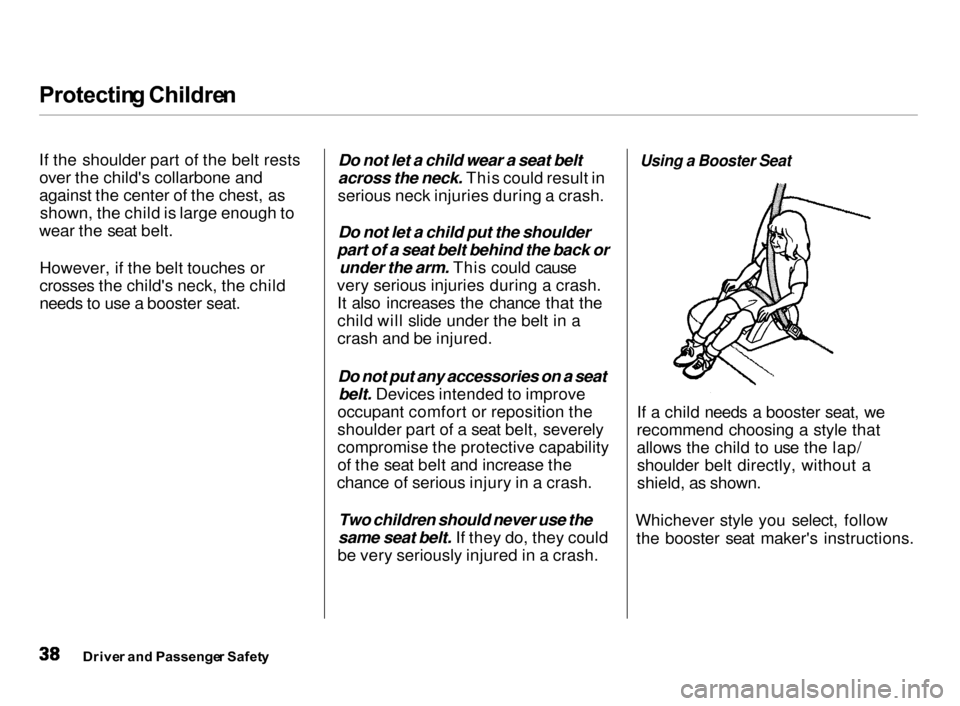
Protectin
g Childre n
If the shoulder part of the belt rests
over the child's collarbone and
against the center of the chest, as shown, the child is large enough to
wear the seat belt.
However, if the belt touches or
crosses the child's neck, the child
needs to use a booster seat. Do not let a child wear a seat belt
across the neck. This could result in
serious neck injuries during a crash.
Do not let a child put the shoulder
part of a seat belt behind the back or under the arm. This could cause
very serious injuries during a crash. It also increases the chance that the
child will slide under the belt in a
crash and be injured.
Do not put any accessories on a seat
belt. Devices intended to improve
occupant comfort or reposition the
shoulder part of a seat belt, severely
compromise the protective capability
of the seat belt and increase the
chance of serious injury in a crash.
Two children should never use the
same seat belt. If they do, they could
be very seriously injured in a crash.
Using a Booster Seat
If a child needs a booster seat, we
recommend choosing a style that
allows the child to use the lap/ shoulder belt directly, without a
shield, as shown.
Whichever style you select, follow the booster seat maker's instructions.
Drive r an d Passenge r Safet y